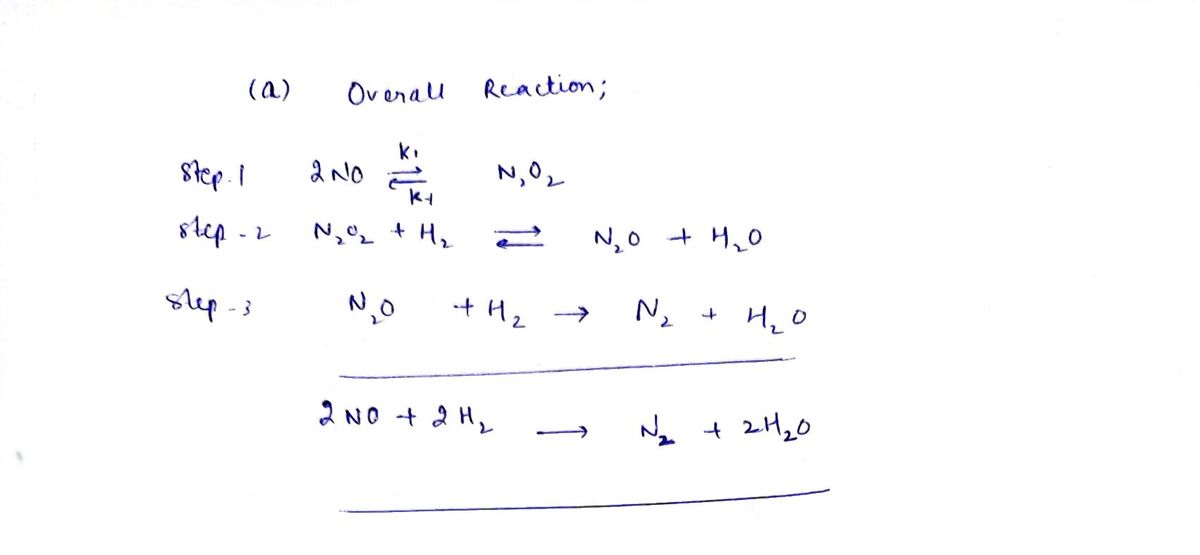The following mechanism has been proposed for the formation of N₂ and H₂O from H₂ and tager mode N₂O₂ (fast, equilibrium) This is reversible Step 1 Step 2 2 NO N₂O₂ H₂ S N₂0 H₂O [fest, quilibrium) This is reversible Step 3 a. What is the overall reaction for this mechanism?/ b. What are the intermedies if my exist Write arate law for each step of the mechanism and the molecularity of each step. Be sure to include any reversible steps as well. Answer this question on the scratch paper clearly labele N₂ H₂O (slow, RDS) This is not reversible d. What is the predicted rate low for this reaction? B paper clearly labeled. What are the expected units for k given the time in units of seconds.
The following mechanism has been proposed for the formation of N₂ and H₂O from H₂ and tager mode N₂O₂ (fast, equilibrium) This is reversible Step 1 Step 2 2 NO N₂O₂ H₂ S N₂0 H₂O [fest, quilibrium) This is reversible Step 3 a. What is the overall reaction for this mechanism?/ b. What are the intermedies if my exist Write arate law for each step of the mechanism and the molecularity of each step. Be sure to include any reversible steps as well. Answer this question on the scratch paper clearly labele N₂ H₂O (slow, RDS) This is not reversible d. What is the predicted rate low for this reaction? B paper clearly labeled. What are the expected units for k given the time in units of seconds.
Chemistry
10th Edition
ISBN:9781305957404
Author:Steven S. Zumdahl, Susan A. Zumdahl, Donald J. DeCoste
Publisher:Steven S. Zumdahl, Susan A. Zumdahl, Donald J. DeCoste
Chapter1: Chemical Foundations
Section: Chapter Questions
Problem 1RQ: Define and explain the differences between the following terms. a. law and theory b. theory and...
Related questions
Question
![**Proposed Mechanism for the Formation of N₂ and H₂O from H₂ and Nitrogen Monoxide**
**Step 1:**
\[ 2 \, \text{NO} \rightleftharpoons \text{N}_2\text{O}_2 \quad (\text{fast, equilibrium}) \]
This step is reversible.
**Step 2:**
\[ \text{N}_2\text{O}_2 + \text{H}_2 \rightleftharpoons \text{NO} + \text{H}_2\text{O} \quad (\text{fast, equilibrium}) \]
This step is reversible.
**Step 3:**
\[ 2 \, \text{NO} + \text{H}_2 \rightarrow \text{N}_2 + 2 \, \text{H}_2\text{O} \quad (\text{slow, RDS}) \]
This step is not reversible.
**Questions:**
1. **Overall Reaction for the Mechanism:** What is the overall reaction of this mechanism?
2. **Intermediates:** What are the intermediates of any steps?
3. **Molecularity of Each Step:** Write a rate law for each step of the mechanism and list the molecularity of each step. Be sure to include any reversible steps as well. Answer this question on the scratch paper clearly beside.
4. **Rate Law Prediction:** What is the predicted rate law for the reaction based on the proposed mechanism?
5. **Units for k:** What are the expected units for k given the time in units of seconds?](/v2/_next/image?url=https%3A%2F%2Fcontent.bartleby.com%2Fqna-images%2Fquestion%2Fd6cc73a6-72c8-4e2b-a22b-5b06a5805dfc%2F81b607a6-83b7-4926-b4fc-d3588ef38027%2Fd1uekeu_processed.jpeg&w=3840&q=75)
Transcribed Image Text:**Proposed Mechanism for the Formation of N₂ and H₂O from H₂ and Nitrogen Monoxide**
**Step 1:**
\[ 2 \, \text{NO} \rightleftharpoons \text{N}_2\text{O}_2 \quad (\text{fast, equilibrium}) \]
This step is reversible.
**Step 2:**
\[ \text{N}_2\text{O}_2 + \text{H}_2 \rightleftharpoons \text{NO} + \text{H}_2\text{O} \quad (\text{fast, equilibrium}) \]
This step is reversible.
**Step 3:**
\[ 2 \, \text{NO} + \text{H}_2 \rightarrow \text{N}_2 + 2 \, \text{H}_2\text{O} \quad (\text{slow, RDS}) \]
This step is not reversible.
**Questions:**
1. **Overall Reaction for the Mechanism:** What is the overall reaction of this mechanism?
2. **Intermediates:** What are the intermediates of any steps?
3. **Molecularity of Each Step:** Write a rate law for each step of the mechanism and list the molecularity of each step. Be sure to include any reversible steps as well. Answer this question on the scratch paper clearly beside.
4. **Rate Law Prediction:** What is the predicted rate law for the reaction based on the proposed mechanism?
5. **Units for k:** What are the expected units for k given the time in units of seconds?
Expert Solution
Step 1
Note! As per bartleby guidelines, we can answer only first three subparts (unless not mentioned anything). so, please upload the rest separately.

Step by step
Solved in 3 steps with 3 images

Knowledge Booster
Learn more about
Need a deep-dive on the concept behind this application? Look no further. Learn more about this topic, chemistry and related others by exploring similar questions and additional content below.Recommended textbooks for you

Chemistry
Chemistry
ISBN:
9781305957404
Author:
Steven S. Zumdahl, Susan A. Zumdahl, Donald J. DeCoste
Publisher:
Cengage Learning

Chemistry
Chemistry
ISBN:
9781259911156
Author:
Raymond Chang Dr., Jason Overby Professor
Publisher:
McGraw-Hill Education

Principles of Instrumental Analysis
Chemistry
ISBN:
9781305577213
Author:
Douglas A. Skoog, F. James Holler, Stanley R. Crouch
Publisher:
Cengage Learning

Chemistry
Chemistry
ISBN:
9781305957404
Author:
Steven S. Zumdahl, Susan A. Zumdahl, Donald J. DeCoste
Publisher:
Cengage Learning

Chemistry
Chemistry
ISBN:
9781259911156
Author:
Raymond Chang Dr., Jason Overby Professor
Publisher:
McGraw-Hill Education

Principles of Instrumental Analysis
Chemistry
ISBN:
9781305577213
Author:
Douglas A. Skoog, F. James Holler, Stanley R. Crouch
Publisher:
Cengage Learning

Organic Chemistry
Chemistry
ISBN:
9780078021558
Author:
Janice Gorzynski Smith Dr.
Publisher:
McGraw-Hill Education

Chemistry: Principles and Reactions
Chemistry
ISBN:
9781305079373
Author:
William L. Masterton, Cecile N. Hurley
Publisher:
Cengage Learning

Elementary Principles of Chemical Processes, Bind…
Chemistry
ISBN:
9781118431221
Author:
Richard M. Felder, Ronald W. Rousseau, Lisa G. Bullard
Publisher:
WILEY